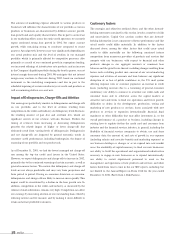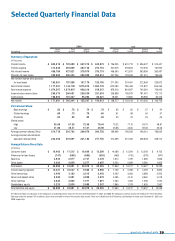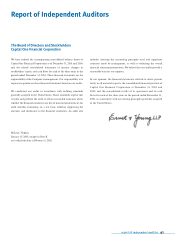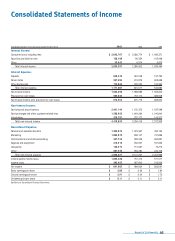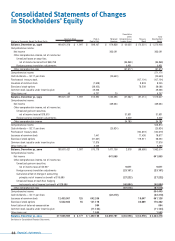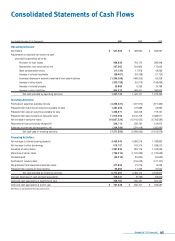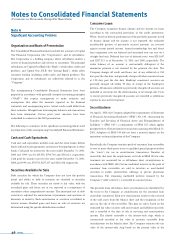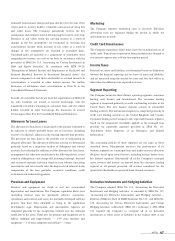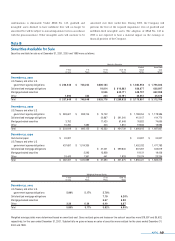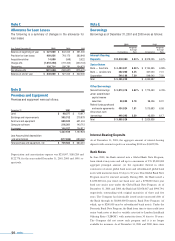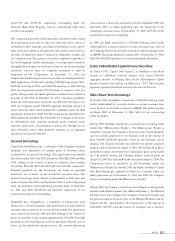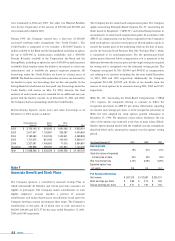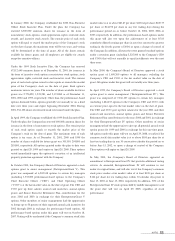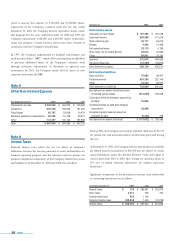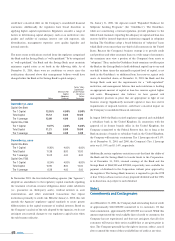Capital One 2001 Annual Report Download - page 50
Download and view the complete annual report
Please find page 50 of the 2001 Capital One annual report below. You can navigate through the pages in the report by either clicking on the pages listed below, or by using the keyword search tool below to find specific information within the annual report.
value. The accounting for changes in the fair value (i.e., gains and
losses) of a derivative instrument depends on whether it has been
designated and qualifies as part of a hedging relationship and, further,
on the type of hedging relationship. For those derivative instruments
that are designated and qualify as hedging instruments, a company
must designate the hedging instrument, based upon the exposure
being hedged, as a fair value hedge, a cash flow hedge or a hedge of a
net investment in a foreign operation. The adoption of SFAS 133
resulted in a cumulative-effect adjustment decreasing other
comprehensive income by $27,222, net of an income tax benefit of
$16,685.
For derivative instruments that are designated and qualify as fair value
hedges (i.e., hedging the exposure to changes in the fair value of an
asset or a liability or an identified portion thereof that is attributable to
a particular risk), the gain or loss on the derivative instrument as well
as the offsetting loss or gain on the hedged item attributable to the
hedged risk is recognized in current earnings during the period of the
change in fair values. For derivative instruments that are designated
and qualify as cash flow hedges (i.e., hedging the exposure to
variability in expected future cash flows that is attributable to a
particular risk), the effective portion of the gain or loss on the
derivative instrument is reported as a component of other
comprehensive income and reclassified into earnings in the same
period or periods during which the hedged transaction affects
earnings. The remaining gain or loss on the derivative instrument in
excess of the cumulative change in the present value of future cash
flows of the hedged item, if any, is recognized in current earnings
during the period of change. For derivative instruments that are
designated and qualify as hedges of a net investment in a foreign
operation, the gain or loss is reported in other comprehensive income
as part of the cumulative translation adjustment to the extent that it is
effective. For derivative instruments not designated as hedging
instruments, the gain or loss is recognized in current earnings during
the period of change.
The Company formally documents all hedging relationships, as well as
its risk management objective and strategy for undertaking the hedge
transaction. At inception and at least quarterly, the Company also
formally assesses whether the derivatives that are used in hedging
transactions have been highly effective in offsetting changes in the
hedged items to which they are designated and whether those derivatives
may be expected to remain highly effective in future periods. The
Company will discontinue hedge accounting prospectively when it is
determined that a derivative has ceased to be highly effective as a hedge.
Prior to January 1, 2001, the Company also used interest rate swap
contracts and foreign exchange contracts for hedging purposes.
Amounts paid or received on interest rate and currency swaps were
recorded on an accrual basis as an adjustment to the related income or
expense of the item to which the agreements were designated. At
December 31, 2000, the related amounts payable to counterparties was
$26,727. Changes in the fair value of interest rate swaps were not
reflected in the financial statements. Changes in the fair value of
foreign currency contracts and currency swaps were recorded in the
period in which they occurred as foreign currency gains or losses in
other non-interest income, effectively offsetting the related gains or
losses on the items to which they were designated. Realized gains and
losses at the time of termination, sale or repayment of a derivative
financial instrument are recorded in a manner consistent with its
original designation. Amounts were deferred and amortized as an
adjustment to the related income or expense over the original period
of exposure, provided the designated asset or liability continued to
exist, or in the case of anticipated transactions, was probable of
occurring. Realized and unrealized changes in the fair value of swaps
or foreign exchange contracts, designated with items that no longer
exist or are no longer probable of occurring, were recorded as a
component of the gain or loss arising from the disposition of the
designated item. At December 31, 2000, the gross unrealized gains in
the portfolio were $23,890. Under the terms of certain swaps, each
party may be required to pledge collateral if the market value of the
swaps exceeds an amount set forth in the agreement or in the event of
a change in its credit rating. At December 31, 2000, the Company had
pledged $55,364 of such collateral.
Recent Accounting Pronouncements
In August 2001, the Financial Accounting Standards Board (“FASB”)
issued SFAS No. 144, “Accounting for the Impairment or Disposal
of Long-Lived Assets.” SFAS No. 144 supersedes SFAS No. 121,
“Accounting for the Impairment of Long-Lived Assets and for Long-
Lived Assets to Be Disposed Of,” but retains the requirements of SFAS
No. 121 to test long-lived assets for impairment and removes goodwill
from its scope. In addition, the changes presented in SFAS No. 144
require that one accounting model be used for long-lived assets to be
disposed of by sale and broadens the presentation of discontinued
operations to include more disposal transactions. Under SFAS No. 144,
discontinued operations are no longer measured on a net realizable
value basis, and future operating losses are no longer recognized before
they occur. The provisions of this Statement are effective for financial
statements issued for fiscal years beginning after December 15, 2001.
The implementation of SFAS No. 144 is not expected to have a
material impact on the earnings or financial position of the Company.
In June 2001, the FASB issued SFAS No. 141,“Business Combinations,”
effective for business combinations initiated after June 30, 2001, and
SFAS No. 142, “Goodwill and Other Intangible Assets,” effective for
fiscal years beginning after December 15, 2001. Under SFAS No. 141,
the pooling of interests method of accounting for business
48 notes


